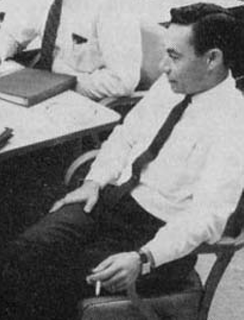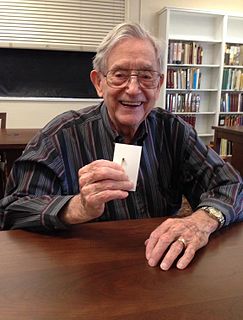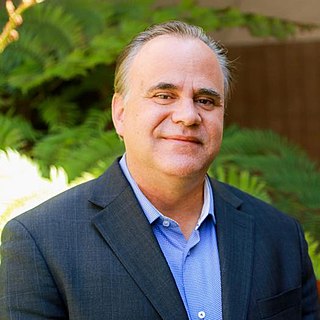
A light-emitting diode (LED) is a semiconductor light source that emits light when current flows through it. Electrons in the semiconductor recombine with electron holes, releasing energy in the form of photons. The color of the light is determined by the energy required for electrons to cross the band gap of the semiconductor. White light is obtained by using multiple semiconductors or a layer of light-emitting phosphor on the semiconductor device.

Artificial lighting technology began to be developed tens of thousands of years ago and continues to be refined in the present day.

Nick Holonyak Jr. is an American engineer and educator. He is noted particularly for his 1962 invention of a light-emitting diode (LED) that emitted visible red light instead of infrared light; Holonyak demonstrated the LED on October 9, 1962 while working at General Electric's research laboratory in Syracuse, New York. He is a John Bardeen Endowed Chair Emeritus in Electrical and Computer Engineering and Physics at the University of Illinois at Urbana-Champaign, where he has been since leaving General Electric in 1963.

Shuji Nakamura is a Japanese-born American electronic engineer and prolific inventor specializing in the field of semiconductor technology, professor at the Materials Department of the College of Engineering, University of California, Santa Barbara (UCSB), and is regarded as the inventor of the blue LED, a major breakthrough in lighting technology.
Aluminium gallium indium phosphide is a semiconductor material that provides a platform for the development of novel multi-junction photovoltaics and optoelectronic devices, as it spans a direct bandgap from deep ultraviolet to infrared.
Federico Capasso, a prominent applied physicist, was one of the inventors of the quantum cascade laser during his work at Bell Laboratories. He is currently on the faculty of Harvard University. He has co-authored over 450 papers, edited four volumes, and holds over 60 US patents.
Nichia Corporation is a Japanese chemical engineering and manufacturing company headquartered in Anan, Japan with global subsidiaries. It specializes in the manufacturing and distribution of phosphors, including light-emitting diodes (LEDs), laser diodes, battery materials, and calcium chloride.

Isamu Akasaki was a Japanese engineer and physicist, specializing in the field of semiconductor technology and Nobel Prize laureate, best known for inventing the bright gallium nitride (GaN) p-n junction blue LED in 1989 and subsequently the high-brightness GaN blue LED as well.
Russell Dean Dupuis is an American physicist.
Gertrude Fanny Neumark, also known as Gertrude Neumark Rothschild, was an American physicist, most noted for her work in material science and physics of semiconductors with emphasis on optical and electrical properties of wide bandgap semiconductors and their light emitting devices.
Epistar Corp. is the largest manufacturer of light-emitting diodes (LEDs) in Taiwan. The company was established in 1996, and its headquarters are in Hsinchu, In 2009 it had an annual turnover of NT$10 billion.

Sorab (Soli) K. Ghandhi was a professor Emeritus at Rensselaer Polytechnic Institute (RPI) known for his pioneering work in electrical engineering and microelectronics education, and in the research and development of Organometallic Vapor Phase Epitaxy (OMVPE) for compound semiconductors. He was the recipient of the IEEE Education Award "For pioneering contributions to semiconductor and microelectronics education" in 2010.

Dawon Kahng was a Korean-American electrical engineer and inventor, known for his work in solid-state electronics. He is best known for inventing the MOSFET, along with his colleague Mohamed Atalla, in 1959. Kahng and Atalla developed both the PMOS and NMOS processes for MOSFET semiconductor device fabrication. The MOSFET is the most widely used type of transistor, and the basic element in most modern electronic equipment.

Mohamed M. Atalla was an Egyptian-American engineer, physical chemist, cryptographer, inventor and entrepreneur. He was a semiconductor pioneer who made important contributions to modern electronics. He is best known for inventing the MOSFET in 1959, which along with Atalla's earlier surface passivation and thermal oxidation processes, revolutionized the electronics industry. He is also known as the founder of the data security company Atalla Corporation, founded in 1972. He received the Stuart Ballantine Medal and was inducted into the National Inventors Hall of Fame for his important contributions to semiconductor technology as well as data security.

James R. "Bob" Biard is an American electrical engineer and inventor who holds 73 U.S. patents. Some of his more significant patents include the first infrared light-emitting diode (LED), the optical isolator, Schottky clamped logic circuits, silicon Metal Oxide Semiconductor Read Only Memory, a low bulk leakage current avalanche photodetector, and fiber-optic data links. He has been on the staff of Texas A&M University as an Adjunct Professor of Electrical Engineering since 1980.

Hiroshi Amano is a Japanese physicist, engineer and inventor specializing in the field of semiconductor technology. For his work he was awarded the 2014 Nobel Prize in Physics together with Isamu Akasaki and Shuji Nakamura for "the invention of efficient blue light-emitting diodes which has enabled bright and energy-saving white light sources".
Roger John Malik is a physicist, engineer and inventor.

Steven P. DenBaars is an American material scientist, electrical engineer, and academic. He is a Professor of Materials and Electrical and Computer Engineering, and the Executive Director of the Solid State Lighting and Energy Electronics Center at the University of California, Santa Barbara. He is also a Fellow of National Academy of Inventors (NAI), and was selected as a Member of National Academy of Engineering (NAE) in 2012 for contributions to gallium nitride-based materials and devices for solid state lighting and displays.
In light-emitting diode physics, the recombination of electrons and electron holes in a semiconductor produce light, a process called "electroluminescence". The wavelength of the light produced depends on the energy band gap of the semiconductors used. Since these materials have a high index of refraction, design features of the devices such as special optical coatings and die shape are required to efficiently emit light. A LED is a long-lived light source, but certain mechanisms can cause slow loss of efficiency of the device or sudden failure. The wavelength of the light emitted is a function of the band gap of the semiconductor material used; materials such as gallium arsenide, and others, with various trace doping elements, are used to produce different colors of light. Another type of LED uses a quantum dot which can have its properties and wavelength adjusted by its size. Light-emitting diodes are widely used in indicator and display functions, and white LEDs are displacing other technologies for general illumination purposes.
Rubin Braunstein (1922–2018) was an American physicist and educator. In 1955 he published the first measurements of light emission by semiconductor diodes made from crystals of gallium arsenide (GaAs), gallium antimonide (GaSb), and indium phosphide (InP). GaAs, GaSb, and InP are examples of III-V semiconductors. The III-V semiconductors absorb and emit light much more strongly than silicon, which is the best-known semiconductor. Braunstein's devices are the forerunners of contemporary LED lighting and semiconductor lasers, which typically employ III-V semiconductors. The 2000 and 2014 Nobel Prizes in Physics were awarded for further advances in closely related fields.











